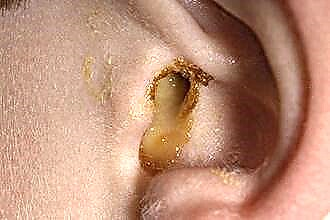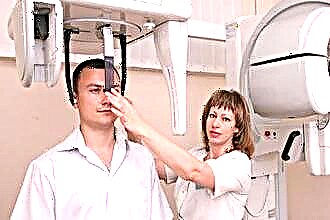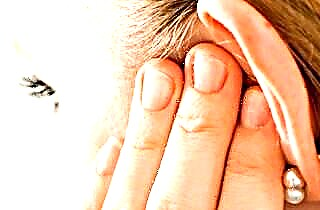The appearance of painful sensations in the ear is often accompanied by a deterioration in hearing function, which significantly reduces the quality of human life. When contacting an otolaryngologist, in most cases, a widespread inflammatory process is detected, covering the middle ear, nasopharynx or oropharynx. When a sore throat radiates to the ear, it is worth suspecting a complicated course of the disease.
 First, let's figure out why the infection can get from the throat to the ear. The mechanism of the spread of infectious microorganisms is due to the structural features of this zone.
First, let's figure out why the infection can get from the throat to the ear. The mechanism of the spread of infectious microorganisms is due to the structural features of this zone.
The middle ear section consists of a cavity as well as ossicles. To ensure the auditory function, the maintenance of atmospheric pressure in the cavity is required. This is done through the Eustachian tube connecting the middle ear to the nasopharynx. When saliva is swallowed, the auditory tube opens slightly, after which the pressure in the cavity is equalized.
Quite often, in sick people, it "lays" or "shoots" in the ear, which is also due to the pathology of the Eustachian tube:
- the spread of the inflammatory reaction leads to eustachitis;
- swelling of the auditory tube;
- increased secretion by glands in the oropharynx partially overlaps the tubal lumen;
- an increase in lymphoid pharyngeal formations. Tubal tonsils are localized near the opening of the auditory tube, which also narrows its lumen. Children often have swelling of the pharyngeal tonsil (adenoids), which increases the risk of ear pain due to sore throat.
Note that in children, the lumen of the auditory tube is much smaller, therefore, their throat and ears are affected almost simultaneously.
With the spread of an inflammatory reaction and infectious pathogens, otitis media develops into the middle ear section. In the tympanic cavity, there is an increase in the production of inflammatory fluid, which leads to ear pain and impairment of hearing function. Also, the patient complains of noise, crackling in the ear and a sensation of fluid transfusion.
If the throat hurts for a long time and gives it to the ear, and there is no treatment, the risk of serious complications increases:
- purulent otitis media develops due to intense
 reproduction of pathogenic microbes, which predisposes the appearance of purulent discharge.
reproduction of pathogenic microbes, which predisposes the appearance of purulent discharge. - perforation of the membrane is noted with the accumulation of a large volume of purulent masses in the cavity, an increase in pressure on the membrane and its melting. After perforation of the membrane, suppuration of their ear is observed, while the pain may decrease somewhat.
- meningitis;
- brain abscess;
- mastoiditis;
- sepsis (with generalization of the infection).
Causes of ear pain
When a sore throat hurts and radiates into the ear, both infectious microorganisms and non-infectious factors can cause this. So, sore throat and ear pain can be caused by:
| Disease | The reason for the development | Symptoms |
| ARVI | adenoviruses, rhinoviruses, parainfluenza, swine / avian influenza | a person is worried about a stuffy nose, rhinorrhea, low-grade hyperthermia, lacrimation, sore throat and ear, malaise, loss of appetite, joint aches, headache |
| angina | streptococcus, staphylococcus | severe sore throat, febrile hyperthermia, malaise, headache, enlargement of the tonsils, the appearance of plaque on their surface |
| measles | measles virus Morbillivirus | headache, insomnia, fever, mucopurulent rhinorrhea, sore throat, lacrimation, regional lymphadenitis, rashes that spread from the head to the extremities (by the end of 3 days) |
| rubella | rubella virus Rubivirus | malaise, pyrexia, runny nose, sore throat, lacrimation, regional lymphadenitis, pruritus, rashes |
| chicken pox | herpes virus type 3 | body aches, fever, dyspeptic disorders, rash, sore throat, itchy skin |
| diphtheria | Leffler's bacillus (diphtheria bacillus) | febrile hyperthermia, sore throat, worn on the tonsils, headache, lymphadenitis |
With the development of cancer, the throat also hurts, it gives to the ears. At the initial stage, disturb the perspiration, discomfort in the oropharynx. As the tumor grows, the swallowing process becomes more difficult, the lumen of the organs of the digestive and respiratory systems decreases. It is possible to suspect a malignant disease on the basis of a decrease in body weight, a decrease in appetite, an increase in regional lymph nodes. They become dense, painful, connect with each other and adjacent tissues, forming an immobile conglomerate.
With damage to the nerve, the fibers of which pass through the root of the tongue, pharynx, the throat and ear on one side also hurt.
With neuritis, the pain in the throat is burning and sharp.
Otitis media treatment
When the ear begins to hurt, it is necessary to start treatment without waiting for complications to appear. Before using ear drops, you should make sure that the membrane is intact. Only a specialist will help with this.
If the eardrum has ruptured, do not use alcohol-based ear drops.
 Whether the soreness is on the left or right side, ear drops are indicated for both ears. This will help not only get rid of clinical symptoms, but also prevent the spread of infection from the nasopharynx / oropharynx to the second ear. For a sore ear, the appointment of a therapeutic dosage is required, for the second, a prophylactic dose is sufficient.
Whether the soreness is on the left or right side, ear drops are indicated for both ears. This will help not only get rid of clinical symptoms, but also prevent the spread of infection from the nasopharynx / oropharynx to the second ear. For a sore ear, the appointment of a therapeutic dosage is required, for the second, a prophylactic dose is sufficient.
With the integrity of the membrane, solutions with analgesic properties are used to reduce pain, for example, Otipax or Otinum. If the membrane ruptures, drops are needed, which include an antibacterial agent, such as Otofa or Ciprofarm.
When a stroke lesion of the ear is confirmed, drops of Candibiotic or Miramistin are prescribed. If it is necessary to use a hormonal agent, the appointment of Sofradex is recommended.
When sore throat and ears are blocked, a comprehensive therapeutic approach is required. In the treatment of pain in the ear, drugs are also used for systemic administration:
- antihistamines, for example, Tavegil, Suprastin. They help to reduce the swelling of the mucous membrane of the auditory tube, to expand its lumen, thereby improving the ventilation function. Sanitation of the middle ear section will ensure the inhibition of the activity of pathogenic microbes.
- when nausea occurs, antiemetics are prescribed, for example, Cerucal. Nausea indicates damage to the inner ear region.
- in the absence of purulent masses, however, with massive secretion of serous discharge, hormonal agents are recommended;
- antipyretics are indicated to combat fever. The use of non-steroidal anti-inflammatory drugs will not only reduce hyperthermia, but also the severity of inflammation.
In otitis media, the use of systemic antibacterial drugs is shown. Often appointed  cephalosporins (Cephalexin, Zinnat) or penicillins (Amoxicillin). Antibiotic therapy is prescribed based on the sensitivity of microbes to antibiotics. For culture, exudate is taken from the ear or a swab from the pharynx or nasopharynx is performed.
cephalosporins (Cephalexin, Zinnat) or penicillins (Amoxicillin). Antibiotic therapy is prescribed based on the sensitivity of microbes to antibiotics. For culture, exudate is taken from the ear or a swab from the pharynx or nasopharynx is performed.
The use of antibacterial drugs that have a toxic effect on the auditory organ (neomycin, gentamicin) is prohibited.
To stop giving pain to the ear zone, it is necessary to use local therapy. In addition to ear drops, physiotherapy is widely used after the end of the acute period. Among physiotherapy procedures, it is advisable to use UHF, warming compresses or sollux. The use of scopolamine patches is also shown.
If the infectious-inflammatory process has damaged the ear on the right or left side, and conservative therapy has not led to a good result, surgical intervention is recommended. The scope of the operation may consist in dissecting the membrane, opening the labyrinth and temporal pyramid.
Eliminating the source of infection
If the throat hurts on one side, and the pain radiates to the ear area, gargling procedures are necessarily used in the treatment. For this, drugs are prescribed that have anti-inflammatory, antimicrobial, analgesic and anti-edema effects.
Of the medicines, in most cases, Miramistin, Givalex, Stopangin, Tantum-Verde, Chlorophyllipt, Chlorhexidine, Rotokan, Furacilin and other solutions are used.
To obtain the maximum therapeutic effect, it is necessary to alternate solutions during the day, preventing the development of resistance of pathogenic microbes to a certain drug. The procedures are repeated every 90 minutes. To facilitate rinsing, tilt your head back a little and exhale the air through your mouth for as long as possible. As a result, the solution will penetrate as deeply as possible into the oropharynx.
The procedure requires heating the water to 40 degrees. This will avoid irritating effects from cold water and prevent burns of the mucous membrane. After rinsing, do not drink / eat food for half an hour.
If it is not possible to rinse (in a public place), and the sore throat is very strong, you can use solutions in the form of a spray. They are also about show analgesic, antiseptic and anti-inflammatory effects. Of these drugs, it is worth highlighting Strepsils Plus, Stopangin, Tantum-Verde, Bioparox (with an antibacterial component), Givadex, Geksoral, Chlorophyllipt, Septolete and other solutions.
show analgesic, antiseptic and anti-inflammatory effects. Of these drugs, it is worth highlighting Strepsils Plus, Stopangin, Tantum-Verde, Bioparox (with an antibacterial component), Givadex, Geksoral, Chlorophyllipt, Septolete and other solutions.
From tablet medicines, it is recommended to take Septefril, Strepsils, Septolete, Faringosept, Decatilen, Lizak and other tablets for resorption.
Folk recipes
The therapeutic effect of local exposure will be much better if taken orally with decoctions of herbs. They will help reduce the severity of intoxication syndrome, accelerate the elimination of toxins from the body and reduce hyperthermia. From medicinal plants, you can use chamomile, sage, yarrow, linden and other herbs. One part of the broth can be taken orally, the other for rinsing.
Here's one recipe:
- leaves of nettle, black currant and St. John's wort in a volume of 2 g should be infused in a thermos (280 ml) for about 5 hours. Drink like tea twice a day.
Boric acid can be dripped into the ear by covering the ear canal with a cotton swab.
It is advisable to stay in bed during the illness, avoid drafts, contact with sick people and drink up to 2-2.5 liters of liquid per day. It can be juices, tea, jelly or fruit drink.
Don't forget about the old proven recipes:
- you should drink milk with honey;
- dissolve a piece of honey, which will help not only relieve a sore throat, but also calm the nervous system;
- tea with raspberries, black currants, lemon;
- for rinsing, a soda-salt solution is used, for which it is enough to mix 5 g of ingredients and dissolve them in warm water with a volume of 190 ml. If iodine-containing preparations are tolerated, you can add a couple of drops of iodine. This will greatly enhance the therapeutic effect.
Pain in the throat radiating to the ear requires complex treatment.
The appearance of soreness in the ear indicates the spread of infection and inflammation along the auditory tube, which is a complication of the underlying disease. If within three days it was not possible to stop the pain, and it intensified, you should consult a doctor.

 reproduction of pathogenic microbes, which predisposes the appearance of purulent discharge.
reproduction of pathogenic microbes, which predisposes the appearance of purulent discharge.

